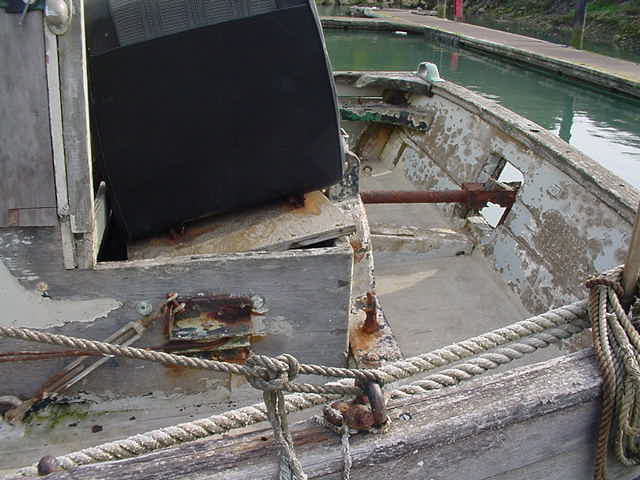The simplest and least expensive steering system is a stick attached to the rudder. But that usually means sitting out in a cockpit when you drive and that can be miserable, so many people, especially with power boats, want some sort of a steering system. The easiest way to do that is simply order anew hydraulic system from the catalog. But, there’s plenty of other ways of hooking up remote steering that work well too, and if money is any issue, some of the more traditional ideas might be just the thing. Actually, even if money is NOT an issue. There’s something to be said for pure simplicity and the ability to repair all parts of a system shipboard. Here’s a few things I’ve seen walking the docks recently.
 |
This fine old sailboat is likely ending her days here in Brookings, Oregon. Her steering system is a tiller connected to the rudder post. The photos below show what happens then….. |
 |
The tiller extends into a deck box, and steering cables come down the sides of the pilot house, through the box, and connect to the tiller. |
 |
Here now is the actual steering station. As you’ve seen, the tiller is attached to the rudder post (top photo). There’s ropes that run down the sides of the deck and over to the tiller (middle photo). The ropes then go on down the deck, or rather in this case down the side of the house, into the house to the main wheel (not shown) and then on to this outside station. Don’t let the disrepair of this boat put you off the appeal of the simple steering system. This is a good setup. |
 |
These folks took a steering gear from a junked truck and adapted it to their boat. They said it’s been in use for years without any hassles. This is actually common although I’ve never seen it done like this where the gear is on the stern of a double ender! But many many old powerboats from “Golden Pond Runabouts” to fishboats, use automotive steering systems. |
 |
Here’s an old cement hull that uses hydraulic steering on a “push-pull” lever. This is common double-ender treatment but must be very well installed because the strains on the fittings are severe…. |




